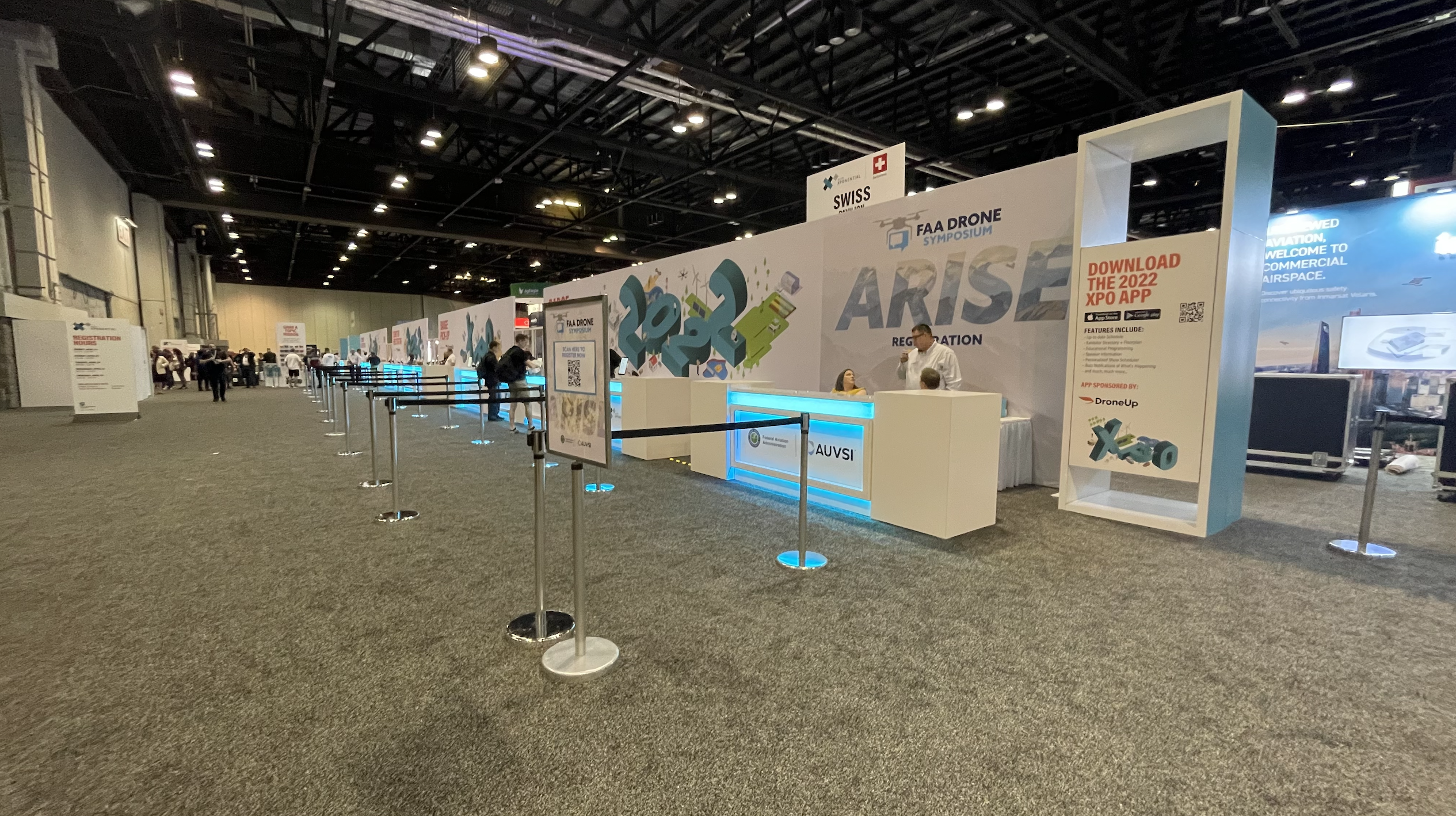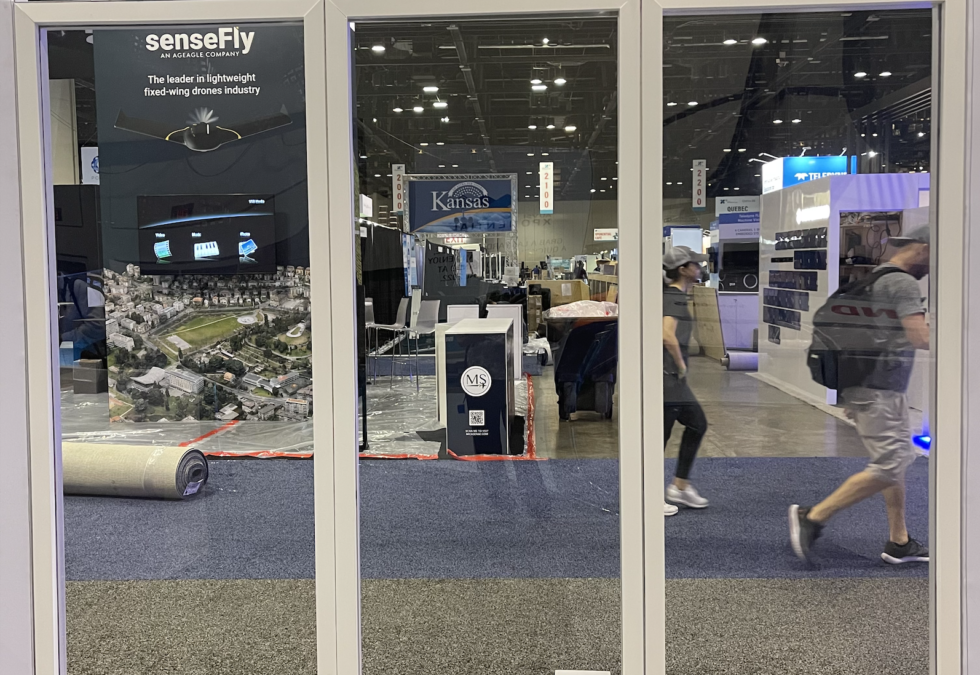Welcome to the Greatest Show on Earth, or at least the biggest when it comes to drones and robots.
The Association for Uncrewed Vehicles Systems International (AUVSI) is back with a full-scale, in-person XPONENTIAL show for the first time since the global pandemic. With members in more than 60 countries – and an ever-increasing number of companies offering products – this is considered the event to attend. The trade floor, when it opens April 26, will showcase products from the world’s largest manufacturers…right through to some of the smallest.
Only exhibitors were allowed in today, setting up their displays. You can get a tiny glimpse of the floor in the background in the following shot. And that woman with the yellow tie? She means business. No one on the floor without an exhibitor’s pass. Don’t even ask.

As usual, there were some smaller educational seminars and panels on a day when a lot of people were still registering. To give you a sense of scale, check out how large the registration area is. Given that it takes only about a minute to get your pass, maximum, this is massive.

Sessions
We took in a few sessions today, just to get warmed up for the main event. A couple of them had some pretty interesting little nuggets.
For example, there was a panel called “When does a vehicle become the driver?” which raised some intriguing points we hadn’t considered. For example, disability activists are keen to have a voice at the table for autonomous vehicles due to the obvious advantages they will provide for those unable to drive a regular car. Wiley Deck, the VP of Government Affairs and Public Policy with the autonomous trucking firm Plus, said he’s heard many with disabilities say “‘We want to be in at the front door, and we think we deserve that’.”
Makes sense. And, arguably, autonomous vehicles might be a boon for elderly people whose decision-making skills and reaction times have diminished with age. But when it comes to legislation, that raises another question.
“Fewer and fewer people will be human drivers,” said Kelly Bartlett, a Connected and Automated Vehicle Specialist with the Michigan Department of Transport (and a guy who thinks about laws a lot).
“We’ve got to decide, who is that person? Maybe it’s a Level 4 or Level 5 (autonomous vehicle). Who is that person? Do they have to know traffic laws, for example?”
Interesting question, and one Barlett said will have to be tackled by legislators at some point in the future.
Autonomous trucking will take time
One of the other striking things from the panel, considering the capabilities of vehicles like those from Tesla, is that the world of autonomous long-haul trucking isn’t coming anytime soon.
If the route were a simple A-B, things would be easier. But the reality, said panelists, is that most of the millions of trucks hitting the road daily in the US have complex routes. They need to stop for fuel or, in the future, for charging. They need to cross states that have different laws. And, just as there are concerns with drones conflicting with traditional aviation, regulators and the public will need to be satisfied these vehicles are truly safer – and in all scenarios.
For example: What would happen if a front steering tire of an autonomous truck blew out at highway speeds? We don’t actually know yet, though at some point such tests will be carried out on tracks. Think of how many scenarios might be involved – how does an autonomous vehicle react to an oil slick? When being towed?
Lots to think about. Speaking of which, when do you predict autonomous trucks will be ubiquitous? Five years? Ten?
According to the panel, you’d be premature.
“It’s decades away,” said Wiley Deck. “If you’re entering the industry now, you’ll be able to retire as a trucker.”
There was also an amazing story about one of the first autonomous vehicle demonstrations, way back in 1925. Too long to go into here, but there’s a fascinating read here, if you’re inclined. It even involves Houdini.
Blue sUAS
You may have heard of Blue sUAS. It’s a list of drones that have been vetted by a Department of Defense branch called the Defense Innovation Unit to comply with the National Defense Authorization Act in the United States. You might think of them as an “approved” list of non-weaponised drones for use by the military, or those using federal funds. Drones using major components manufactured in China are excluded, including DJI. There are also fairly rigid cybersecurity hurdles the drones must pass.
But that has led to some confusion – and concern among organizations that cannot afford the vetted drones. Shelby Ochs, seen in the next photo, is the Program Manager, Autonomy, with the Defense Innovation Unit. They’re the folks that vetted the first list of Blue sUAS drones. At the moment, that list contains eight drones, listed here.

Problem is, when the Defense Innovation Unit first came out with its initial list of Blue sUAS, many people in government, law enforcement, and – albeit rarely – some commercial companies, believed these were the only drones they could purchase.
“People thought this was a prescriptive list,” says Ochs. “So there were a lot of agencies in the federal government who said: ‘If they’re good enough for the Department of Defense, they’re good enough for us, too.'”
That, in his opinion, was a mistake. And he emphasized the following point multiple times during his presentation. In fact, he said it at least three times:
“Any company can sell any drone to any organization, so long as it meets their administrative requirements.”
So that cleared things up. Also of note, Ochs says the Defense Innovation Unit has been looking at adding more drones to the list – and another 15 US-made drones are currently under consideration. He also predicts that average prices of US-made, Blue sUAS products will come down over time.
That’s it for now. Check in later, as we’ll be posting lots of cool content from XPONENTIAL.

